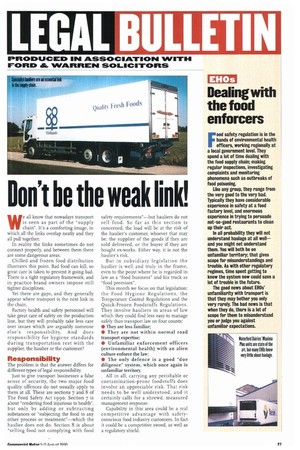Don't be the weak link!
Page 29

If you've noticed an error in this article please click here to report it so we can fix it.
We all know that nowadays transport is seen as part of the "supply chain". It's a comforting image, in which all the links overlap neatly and they all pull together.
In reality the links sometimes do not connect properly, and between them there are some dangerous areas.
Chilled and frozen food distribution illustrates this point. Bad food can kill, so great care is taken to prevent it going bad. There is a tight regulatory framework, and in practice brand owners impose still tighter disciplines.
Yet there are gaps, and they generally appear where transport is the next link in the chain.
Factory health and safety personnel will take great care of safety on the production line, but they will probably take less care over issues which are arguably someone else's responsibility. And does responsibility for hygiene standards during transportation rest with the supplier, the haulier or the customer?
Responsibility
The problem is that the answer differs for differe.nt types of legal responsibility.
Just to give transport businesses a false sense of security, the two major food quality offences do not usually apply to them at all. These are sections 7 and 8 of The Food Safety Act 199o. Section 7 is about "rendering food injurious to health", but only by adding or subtracting substances or "subjecting the food to any other process or treatment"—which the haulier does not do. Section 8 is about "selling food not complying with food safety requirements"—but hauliers do not sell food. So far as this section is concerned, the load will be at the risk of the haulier's customer, whoever that may be: the supplier of the goods if they are sold delivered, or the buyer if they are bought ex-works. Either way, it is not the haulier's risk.
But in subsidiary legislation the haulier is well and truly in the frame, even to the point where he is regarded in law as a "food business" and his truck as "food premises".
This month we focus on that legislation: the Food Hygiene Regulations, the Temperature Control Regulations and the Quick-Frozen Foodstuffs Regulations. They involve hauliers in areas of law which they could find less easy to manage safely than transport law on four counts:
• They are less familiar; • They are not within normal road transport expertise; • Unfamiliar enforcement officers (environmental health) with an alien culture enforce the law; • The only defence is a good "due diligence" system, which once again is unfamiliar territory.
All in all, carrying any perishable or contamination-prone foodstuffs does involve an appreciable risk. That risk needs to be well understood, and it certainly calls for a shrewd, measured management response.
Capability in this area could be a real competitive advantage with safety. conscious food industry customers. In fact it could be a competitive sword, as well as a regulatory shield.








































































































